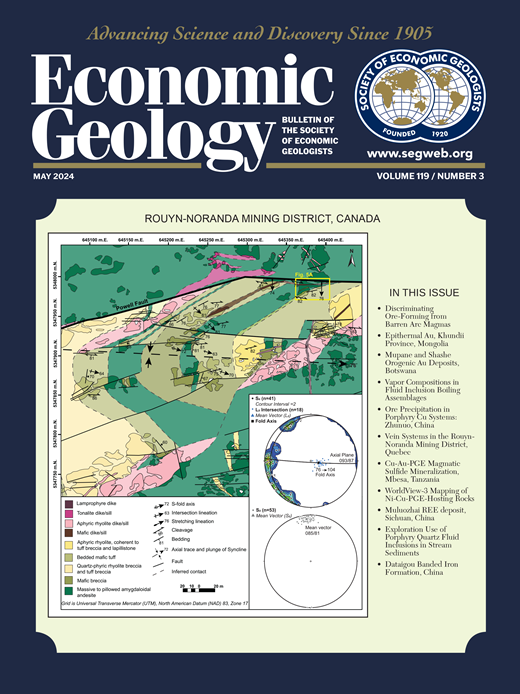Trace Elements in Chromite as Indicators of the Origin of the Giant Podiform Chromite Deposit at Kempirsai, Kazakhstan
IF 5.5
1区 地球科学
Q1 GEOCHEMISTRY & GEOPHYSICS
引用次数: 3
Abstract
This study presents a complete trace element data set of chromite from the world’s largest podiform chromite deposit at Kempirsai, Kazakhstan, together with platinum group element (PGE) and Re-Os isotope compositions, to explore the potential of trace elements in the study of podiform chromite deposits. Chromite orebodies in the Karaagash area of the Kempirsai Main ore field are hosted by dunites in the mantle sequence of the ophiolite. Dunites slightly distal to the orebodies are composed of olivine (forsterite content = 91.5–93.4) and minor euhedral chromite with variable Cr# (0.73–0.83). These dunites have primitive mantle-normalized Pt-Pd–poor PGE patterns and subchondritic 187Os/188Os ratios (0.12174–0.12220). Negative correlations between Cr# and incompatible trace elements (Sc and Ti) of the chromite are consistent with melt-rock reaction, whereas positive correlations between Cr# and compatible trace elements (V and Ga) reflect the role of fractional crystallization. It is therefore proposed that chromite in the distal dunites was crystallized from magmas after reaction with mantle peridotites. In comparison, chromite grains in the ores and adjacent dunites exhibit relatively uniform Cr# numbers (0.81–0.86) and higher 187Os/188Os values (0.12319–0.12414). Both compatible and incompatible trace elements of chromite exhibit negative correlations with Cr#, which are best explained by mixing between the modified magma after melt-rock reaction and a later injected magma from a more depleted source. After the ore formation, subsolidus reequilibration between olivine and chromite reduced Mg# and modified divalent trace elements of chromite in the order of Zn > Co = Mn > Ni but did not affect distribution of nondivalent trace elements, except V and Fe3+. The decoupling of redox-sensitive and redox-insensitive trace elements suggests that the redox states have been modified during subsolidus reequilibration. The existing iron equilibrium between olivine and chromite records high fO2 values (quartz-fayalite-magnetite buffer [∆QFM] 0.8–2.4), whereas correction of subsolidus reequilibration results in a decrease of the fO2 values toward the QFM buffer (∆QFM 0.1–0.6), indicating that increase in fO2 was not a critical factor in the ore formation. Principal component analysis and factor analysis were further carried out to identify differences in trace elements between high-Cr and high-Al podiform chromite deposits worldwide. High-Cr chromite deposits have variable divalent trace element compositions and show complex distributions of nondivalent trace elements. The former reflects longer and slower cooling histories of the high-Cr chromite deposits with respect to the high-Al chromite deposits, whereas the latter indicates more variable magma compositions and complex processes during the formation of the high-Cr chromite deposits.铬铁矿中微量元素与哈萨克斯坦金普赛巨型足状铬铁矿矿床成因的关系
本文介绍了世界上最大的足状铬铁矿床——哈萨克斯坦Kempirsai的铬铁矿的完整微量元素数据集,并结合铂族元素(PGE)和Re-Os同位素组成,探讨微量元素在足状铬铁矿床研究中的潜力。金普赛主矿田卡拉加什地区铬铁矿矿体赋存于蛇绿岩地幔层序中。离矿体稍远的Dunites由橄榄石(forsterite含量= 91.5 ~ 93.4)和少量自晶态铬铁矿组成,Cr值变化(0.73 ~ 0.83)。这些泥质岩具有原始的地幔正规整化pt - pd -贫PGE模式和亚球粒质187Os/188Os比值(0.12174 ~ 0.12220)。铬铁矿中Cr#与不相容微量元素(Sc和Ti)呈负相关,与熔岩反应一致;Cr#与不相容微量元素(V和Ga)呈正相关,反映了分馏结晶的作用。因此,认为远端粒岩中的铬铁矿是岩浆与地幔橄榄岩反应结晶而成。相比之下,矿石和相邻的软岩中铬铁矿的Cr#值相对均匀(0.81 ~ 0.86),187Os/188Os值较高(0.12319 ~ 0.12414)。铬铁矿中相容和不相容的微量元素均与Cr#呈负相关,这可能是熔融-岩石反应后的变质岩浆与后来从更枯竭的来源注入的岩浆混合的结果。矿石形成后,橄榄石与铬铁矿之间的亚固态再平衡对铬铁矿中Mg#的还原和二价微量元素的修饰顺序为Zn > Co = Mn > Ni,但对除V和Fe3+外的非二价微量元素的分布没有影响。对氧化还原敏感和对氧化还原不敏感的微量元素的解耦表明,在亚固体再平衡过程中,氧化还原状态发生了改变。橄榄石和铬铁矿之间的铁平衡记录了较高的fO2值(石英-铁矾石-磁铁矿缓冲带[∆QFM] 0.8 ~ 2.4),而修正亚固体再平衡导致fO2值向QFM缓冲带(∆QFM 0.1 ~ 0.6)下降,表明fO2的增加不是成矿的关键因素。通过主成分分析和因子分析,确定了世界各地高铬高铝足状铬铁矿床中微量元素的差异。高铬铬铁矿中微量元素的二价组成变化较大,非二价微量元素分布复杂。前者反映了高铬铬铁矿相对于高铝铬铁矿较长、较慢的冷却历史,而后者则表明高铬铬铁矿形成过程中岩浆成分变化较大,过程复杂。
本文章由计算机程序翻译,如有差异,请以英文原文为准。
求助全文
约1分钟内获得全文
求助全文
来源期刊

Economic Geology
地学-地球化学与地球物理
CiteScore
10.00
自引率
6.90%
发文量
120
审稿时长
6 months
期刊介绍:
The journal, now published semi-quarterly, was first published in 1905 by the Economic Geology Publishing Company (PUBCO), a not-for-profit company established for the purpose of publishing a periodical devoted to economic geology. On the founding of SEG in 1920, a cooperative arrangement between PUBCO and SEG made the journal the official organ of the Society, and PUBCO agreed to carry the Society''s name on the front cover under the heading "Bulletin of the Society of Economic Geologists". PUBCO and SEG continued to operate as cooperating but separate entities until 2001, when the Board of Directors of PUBCO and the Council of SEG, by unanimous consent, approved a formal agreement of merger. The former activities of the PUBCO Board of Directors are now carried out by a Publications Board, a new self-governing unit within SEG.
 求助内容:
求助内容: 应助结果提醒方式:
应助结果提醒方式:


